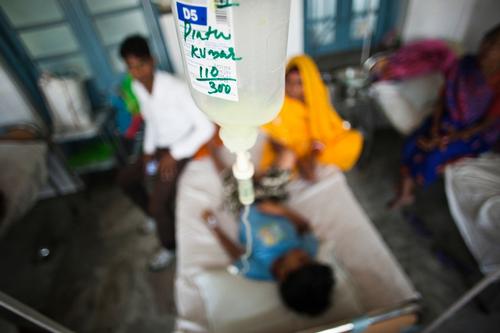On World Health Day, commemorated April 7th, the international medical humanitarian organisation Médecins Sans Frontières (MSF) is calling on the Bihar government and the National Vector Borne Disease Control programme (NVBDCP) to recognise and treat Post Kala azar Dermal Leishmaniasis (PKDL), a neglected complication of kala azar in Bihar (India).
5-10 % of kala azar patients in India develop PKDL
PKDL is a neglected complication of kala azar (Visceral Leishmaniasis) where patients develop skin lesions in the form of rashes and boils on the skin, usually six months to one year after the completion of kala azar treatment. PKDL provides easy access for the sandfly to pick up the parasites. According to the World Health Organisation 5-10 % of kala azar patients in India develop PKDL.
PDKL highly infectious
“Although PDKL is not dangerous for the patient, it can be highly infectious as parasites may be present in the raised areas of the skin, acting as a major reservoir for the transmission of kala azar,” says Dr. Prince Mathew, Deputy Medical Coordinator, India. “For this reason, both NVBDCP and the state government need to pay more attention to PKDL as its awareness, active case detection and treatment is essential in the control of kala azar in the state.”
“In 2005, the Indian government supported WHO’s call for eliminating the disease from the region by 2015 and the state health authorities are working towards achieveing this goal,” says Dr. Jagdish Singh, State Program Officer for NVBDCP in Bihar.
PKDL is considered to have an important role in maintaining and contributing to transmission of the disease particularly in inter-epidemic periods of kala azar, acting as a reservoir for parasites. In the coming years control of PKDL with effective diagnosis and treatment, will play a key role in the ongoing efforts to eliminate kala azar in India. Over the past few years, several expert meetings have recommended that a greater focus on PKDL was needed in endemic countries like India.
10,000 kala azar cases every year
Bihar, one of the most endemic areas in the country with 10,000 cases of kala azar annually, is now showing a positive trend with a decrease in the number of cases. But with PKDL acting as a reservoir for the transmission of kala azar, efforts to reach the target of elimination of this neglected disease by 2015 will be undermined.
“MSF is now not only focusing on treatment of kala azar but also on the diagnosis and management of PKDL in its medical project in Bihar ,” says Joao Antunes, Field Coordinator, Hajipur. “We call on the Indian Health Ministry, NVBDCP and the state government to increase awareness and formulate an effective protocol for the diagnosis and management of PKDL in the state. In India, control of kala azar in the long run requires control of PKDL”.
MSF is on the frontline of combating kala azar – a neglected tropical disease – endemic in Bihar. Since 2007, MSF has been running a kala azar diagnostic and treatment project in Vaishali district. MSF has treated over 12,000 kala azar patients in Bihar. Through its medical project, MSF has proved that it is possible to diagnose and treat kala azar patients with a high cure rate even in resource poor settings. It is now essential to increase patient access to proper diagnosis and treatment to fight against the disease in Bihar.



